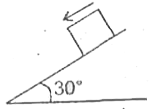A balloon os mass 2 KG is rising up with an acceleration of 4ms2 . The upward force acting on the balloon is (g=10ms−2
0.8 kgf
2.8 kgf
2.4 kgf
2.0 kgf
The correct Answer is:b
To solve the problem of finding the upward force acting on a balloon with a mass of 2 kg that is rising with an acceleration of 4 m/s², we can follow these steps:
1. Identify the forces acting on the balloon:
- The upward force (F) acting on the balloon.
- The downward force which is the weight of the balloon (W).
2. Calculate the weight of the balloon:
- The weight (W) can be calculated using the formula:
W=m⋅g
- Where:
- m=2kg (mass of the balloon)
- g=10m/s2 (acceleration due to gravity)
- Therefore:
W=2kg⋅10m/s2=20N
3. Apply Newton's second law of motion:
- According to Newton's second law, the net force (F_net) acting on the balloon is given by:
Fnet=m⋅a
- Where:
- a=4m/s2 (acceleration of the balloon)
- Thus:
Fnet=2kg⋅4m/s2=8N
4. Set up the equation for the forces:
- The net force acting on the balloon can also be expressed as:
F−W=Fnet
- Substituting the known values:
F−20N=8N
5. Solve for the upward force (F):
- Rearranging the equation gives:
F=8N+20N=28N
6. Convert the force to kgf (kilogram-force):
- To convert Newtons to kilogram-force, we use the conversion factor 1kgf=10N:
Fkgf=28N10N/kgf=2.8kgf
Final Answer:
The upward force acting on the balloon is 28 N or 2.8 kgf.
- The upward force (F) acting on the balloon.
- The downward force which is the weight of the balloon (W).
- The weight (W) can be calculated using the formula:
W=m⋅g
- Where:
- m=2kg (mass of the balloon)
- g=10m/s2 (acceleration due to gravity)
- Therefore:
W=2kg⋅10m/s2=20N
- According to Newton's second law, the net force (F_net) acting on the balloon is given by:
Fnet=m⋅a
- Where:
- a=4m/s2 (acceleration of the balloon)
- Thus:
Fnet=2kg⋅4m/s2=8N
- The net force acting on the balloon can also be expressed as:
F−W=Fnet
- Substituting the known values:
F−20N=8N
- Rearranging the equation gives:
F=8N+20N=28N
- To convert Newtons to kilogram-force, we use the conversion factor 1kgf=10N:
Fkgf=28N10N/kgf=2.8kgf
The upward force acting on the balloon is 28 N or 2.8 kgf.
Topper's Solved these Questions
Similar Questions
A balloon of mass 2 kg is rising up with an acceleration of 4ms2. The upward force acting on the balloon is (g=10ms−2)
View SolutionA balloon is rising up with an acceleration of 10m/s2. A body is dropped from the balloon when its velocity is 200 m/s. The body strickes the ground in half a minute. With that velocity did the body hit the ground ? Take g=9.8m/s2.
View Solution
Knowledge Check
A balloon of mass m is rising up with an acceleration a.
AThe upthrust on the balloon is m(g+a).BThe upthrust on the balloon is ma.Cma/(2a+g) mass must be detached in order to double its acceleration.Dm/2 mass must be detached in order to double its acceleration.An object of 2 kg is moving with an acceleration of 4m/s2 . The net force acting on it is
A4.0NB2.0 NC8.0 ND0.5 NA person of 60 kg enters-a lift going up with an acceleration 2m−2. The vertical upward force acting on the person will be (g=10ms−2)
A600 NB720 NC620ND1200N
A person of 70kg mass is lifted vertically upwards by a helicopter with the help of a rope hanging from it.If the helicopter is rising up with an acceleration 4ms2 the tension in the rope is (g=10ms2
View SolutionA balloon starts rising from the ground with an acceleration of 1.25 m/s2 . A stone is released from the balloon after 10s. Determine
(1) maximum height of ston from ground
(2) time taken by stone to reach the ground
View SolutionA block of mass 10 kg is released on rough incline plane. Block start descending with acceleration 2m/s2. Kinetic friction force acting on block is (take g=10m/s2)

View SolutionA person of 60 kg enters a lift going up with an acceleration 2ms−2 The vertical upward force acting on the person will be (g=10ms−2)
View SolutionA balloon of mass 10 kf is raising up with an acceleration of 20ms−2. If a mass of 4 kg is removed from the balloon its acceleration becomes ( take, g=10ms−2)
View Solution
